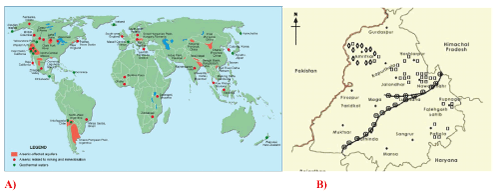Make the best use of Scientific Research and information from our 700+ peer reviewed, Open Access Journals that operates with the help of 50,000+ Editorial Board Members and esteemed reviewers and 1000+ Scientific associations in Medical, Clinical, Pharmaceutical, Engineering, Technology and Management Fields.
Meet Inspiring Speakers and Experts at our 3000+ Global Conferenceseries Events with over 600+ Conferences, 1200+ Symposiums and 1200+ Workshops on Medical, Pharma, Engineering, Science, Technology and Business
Editorial Open Access
Biotechnological Approaches as an Alternative for Bioremediation of Contaminated Ground Water Table Around the Globe
| Sheelendra M. Bhatt* | |
| Lovely School of Biosciences, Lovely Professional University, India | |
| Corresponding Author : | Sheelendra M. Bhatt Assistant Professor, block-28 r.n. 202 Lovely School of Biosciences, Lovely Professional University phagwara-144401, India E-mail: drsmbhatt@gmail.com |
| Received: April 23, 2012; Accepted: April 25, 2012; Published: April 27, 2012 | |
| Citation: Bhatt SM (2012) Biotechnological Approaches as an Alternative for Bioremediation of Contaminated Ground Water Table Around the Globe. J Bioremed Biodegrad 3:e110. doi:10.4172/2155-6199.1000e110 | |
| Copyright: © 2012 Bhatt SM. This is an open-a ccess article distributed under the terms of the Creative Commons Attribution License, which permits unrestricted use, distribution, and reproduction in any medium, provided the original author and source are credited. | |
Related article at Pubmed Pubmed  Scholar Google Scholar Google |
|
Visit for more related articles at Journal of Bioremediation & Biodegradation
| According to USEPA 1999, one of the most hazardous toxic substances causing Arsenicosis enlisted was arsenic (www.atsdr.cdc.gov/cx3.html). According to WHO 1993 guideline the recommended limit that must be assume to be safe in water, should range from 0.05- 0.01 mg/l. In most of the countries (around 34 reported) contamination of arsenic is rising heavily at food chain level due to various reasons via various sources to plant, animal and human. Although the western countries have reduced their national standards in line with this change, in most of the Asian countries (except Japan and Vietnam) it remains at 50 μg/L while limit of arsenic may be lower in some. According to recent report India has been identified among the top 12 in South East Asia [1]. At least 16 states of India including Punjab reported to have alarming level of arsenic as given by Dutta and Kaul [2]. |
| The more alarming region where people are (CSE, 2005, ICMR 2003, PPCD 2005) reported to have cancer at mass level including children of all ages because of heavy use of pesticides that is used to grow cotton in these regions. The core villagers are simply a culprit of this pathetic situation because of heavy rise of arsenic concentration from 1 – 68 ppm in ground water table because of irrigation [3]. Not only the young generation is suffering from ill effects of arsenic but the condition of soil is changing continuously and the plants growing over the soils are continuously becoming the part of food chain. Since they have an ability to accumulate arsenic and other metals, animals depending on those plants are accumulating heavy concentration of arsenic in their meat and milk, therefore the effect of consumption of arsenic enriched food may not be localised but will spread slowly affecting the mass scale. |
| Phytoremediation has emerged as strong ecological tool in restoration of environment and effective remediation of arsenic contaminated soils [4]. Today’s need is to develop sustainable commercially feasible technology that should not only be environmental friendly but also human friendly. Various hyper accumulator species are known today, 400 plant species from 45 plant families for example; Pityrogramma calomelonos accumulation power is 8350 mg as/kg by the leaves [5]. Other known plants are Pteris vitatta (1500-2300 ppm), family including Asteraceae, Brassicaceae, Caryophyllaceous, Cyperceae, Euphobiaceae, Lamiaceae, Poaceae. Indian mustard may be better options for the plain regions for removal of Cd, Cr, Cu, Ni, Pb, Zn. Sunflower may be good option for removal of Pb, U, Cs for hydroponic solution. |
| Currently the scientists are making their efforts in defining the strategies of bioremediation by making various synthetic cross linked polyacrylate hydro gels used to protect plant roots from heavy metal toxicity which is one of the major concerns. Now this engineering has been tried up to gene level and gene responsible for metal hyper accumulation is known and cloned. The metabolism which has been targeted, Glutathione metabolism and organic acid metabolism plays a key role in metal tolerance in plants this strategy is ubiquitous from bacteria to plants and animals (Figure 1). |
| Now filters for various genetically modified plants and microbes are on trial which may impart a unique solution in coming future. For ‘As’ removal there are 2 bacterial genes that express together Arsenate reductase and Gamma-glutamylcysteine synthetase (Gamma ECS) [6]. Lemna gibba is a known bioindicator for ‘As’ [7]. The scientists should look to these novel bacterial genes for expression in hyperaccumulator plants or bio-indicator plant to increase sustainability. |
References
|
Figures at a glance
 |
| Figure 1 |
Post your comment
Relevant Topics
- Anaerobic Biodegradation
- Biodegradable Balloons
- Biodegradable Confetti
- Biodegradable Diapers
- Biodegradable Plastics
- Biodegradable Sunscreen
- Biodegradation
- Bioremediation Bacteria
- Bioremediation Oil Spills
- Bioremediation Plants
- Bioremediation Products
- Ex Situ Bioremediation
- Heavy Metal Bioremediation
- In Situ Bioremediation
- Mycoremediation
- Non Biodegradable
- Phytoremediation
- Sewage Water Treatment
- Soil Bioremediation
- Types of Upwelling
- Waste Degredation
- Xenobiotics
Recommended Journals
Article Tools
Article Usage
- Total views: 14303
- [From(publication date):
May-2012 - Dec 20, 2025] - Breakdown by view type
- HTML page views : 9558
- PDF downloads : 4745
